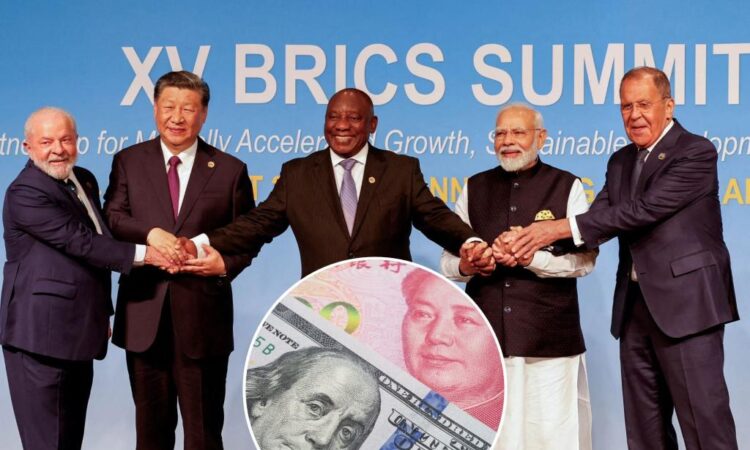
Nearly 15 years after the BRICS coalition of major emerging economies was established in 2009, the group has yet to achieve its ambition of ousting the US dollar as the dominant global currency.
But the alliance — originally comprising Brazil, Russia, India, China, and South Africa — took a major step toward flexing its communal currency muscle at its recent summit in South Africa.
Six new members joined the organization — Saudi Arabia, Iran, Ethiopia, Egypt, Argentina, and the United Arab Emirates — in an effort to reduce the dollar’s decades-long dominance and end its use as the preferred payment for the one commodity that still dominates global trade: oil.
“De-dollarizing” the world economy could have dangerous consequences for the United States.
The dollar’s role as the world’s key reserve currency is the foundation for America’s global leadership.
Dollarization provides the US with outsized influence in shaping international financial policies and forces the global community to adapt to economic decisions made in Washington — and not the other way around.
Most crucially, at a time of unprecedented global conflict, diminishing the dollar’s importance would allow rogue nations such as Iran and Russia to become immune to sanctions in response to geopolitical bad behavior.
Weakening the dollar would also have grave implications here at home.
Lower demand for the currency might make exports cheaper but it will also reduce the dollar’s purchasing power and undermine confidence in its stability.
The resulting higher interest rates and inflation would harm the stock market, and make borrowing to finance our massive federal deficit far more difficult.
As the BRICS summit made clear, the block’s leverage in the oil market has never been greater.
This has given them unprecedented power to finally replace the dollar on the global energy markets with their own domestic currencies.
Take a close look at the selective approach the alliance used to expand its membership.
While the bloc did not provide details about specific admissions criteria, the selection is clearly energy-centric.
Only six out of more than 40 applicant nations were accepted this year — with sizable economies such as Turkey and Indonesia conspicuously left out.
The anti-Western alliance now has six of the world’s top oil producers – Saudi Arabia, Russia, China, Brazil, Iran, and the United Arab Emirates.
It’s also home to two of the world’s largest oil importers – China and India.
The latter pair — Asia’s largest and third-largest economies, respectively — import more than 40% of the world’s crude oil, according to data from Kpler, a commodities market analysis firm.
Although 90% of oil trades are currently conducted in dollars, an increasing number are being handled in Chinese yuan and Russian rubles.
India, for instance, has started paying for Russian oil imports in yuan, and China also began using its yuan to pay Russia for most of its energy imports in the first quarter of this year, according to Reuters.
Saudi Arabia may be new to BRICS, but it’s already colluding with Russia to reduce petroleum production, which has resulted in oil reaching a 10-month high this month.
That reductions, suggests a recent International Energy Agency report, could lead to a “significant supply shortfall” for the rest of the year, keeping gas prices high and fueling inflation.
What’s notable about the BRICS newcomers is that many are authoritarian regimes who are intimately familiar with the power of US sanctions.
Iran, of course, has contended with them for years.
The Saudis — while a crucial US ally — are keen to avoid the “consequences” called for by Biden in October after OPEC+ announced those large production cuts.
Back in 2020, Biden also threatened to make the kingdom a “pariah” over the killing of the Saudi journalist Jamal Khashoggi.
Of course, economics is not the primary driver behind the decision-making of foreign autocrats like those ruling Russia, China, and Iran.
Preserving power, suppressing civil liberties, and ensuring regime stability is what motivates them most.
By shutting Washington out of trade and diplomacy, BRICS membership allows rogue nations to upend our ability to “weaponize” the dollar as a tool to punish bad guys like Putin.
The US has employed sanctions for decades, in lieu of military intervention against authoritarian regimes such as Iran, North Korea, and now Russia.
The White House, for instance, seized $600 billion in Russian assets following its invasion of Ukraine.
Biden also removed Russia from SWIFT, the international money transfer system, sending shock-waves to non-western nations at risk of White House ire.
But sanctions, no matter how robust, have proven ineffective. China and India —both of which have yet to condemn Russia for its invasion of Ukraine — have kept Moscow’s energy revenue flowing, helping to finance Putin’s war machine and highlighting the power of BRICS cooperation.
The BRICS already have a significant presence across the global economy.
With a collective population of more than 3 billion and 31.5% of the world’s GDP, they’re a formidable challenger to the G7 block of the world’s top economic superpowers.
The G-7’s share of global GDP, for instance, is currently at 30%, and projected to fall to 27.95 percent in 2027, according to Statista research.
The dominance of the dollar has driven many non-Western nations to join forces and develop a counterweight to Western economic hegemony.
Fed up with Washington’s use of the greenback as a geopolitical tool, rather than an economic one, the BRICS have finally developed an economic warfare playbook of their own.
And they can now flip it against us at any time.
Rebekah Koffler is the president of Doctrine & Strategy Consulting, a former DIA intelligence officer, and the author of “Putin’s Playbook: Russia’s Secret Plan to Defeat America.”



